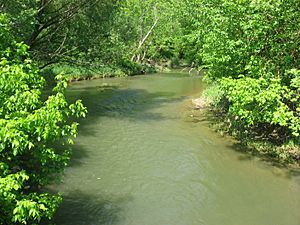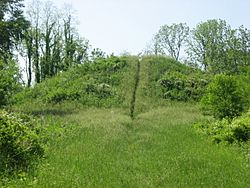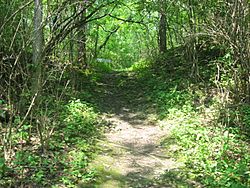Indian Mound Reserve facts for kids
Quick facts for kids |
|
|
Williamson Mound State Memorial
Pollock Works |
|
| Location | Indian Mound Reserve, 2750 U.S. Route 42 |
|---|---|
| Nearest city | Cedarville, Ohio |
| Area | 1.7 acres (0.69 ha) (W) 8 acres (3.2 ha) (P) |
| NRHP reference No. | 71000639 (W) 72001014 (P) |
| Added to NRHP | December 13, 1971 (W) February 23, 1972 (P) |
Indian Mound Reserve is a fun public park located near Cedarville, Ohio, in the United States. This special park is named after two ancient earthworks found within its borders: the Williamson Mound and the Pollock Works. The park is split by Massies Creek, which flows through a cool, small canyon. It's a great place to explore history and nature!
Contents
Exploring Indian Mound Reserve
Massies Creek is a main feature of the park. It flows through a shallow but steep canyon that can be as deep as 40 feet (about 12 meters). This canyon has been a popular spot for over a hundred years. People used to call it the "Cliffs" and enjoyed picnicking there.
In 1929, some land owners gave the Williamson Mound area to the Ohio History Connection. Today, the Greene County Parks manages Indian Mound Reserve. They even host fun events like children's camps here!
When you visit, you can enjoy many attractions:
- Hiking trails
- Picnic areas
- A historic log cabin
- Cedar Cliff Falls, a beautiful waterfall
- The ancient earthworks themselves
The park is located along U.S. Route 42. The two main earthworks are on different sides of Massies Creek. The Pollock Works are on the south side, and the Williamson Mound is about 1,650 feet (500 meters) away on the north side.
The Williamson Mound: An Ancient Burial Site
The Williamson Mound is a very large mound in a field near Massies Creek. In the past, people thought it was a watchtower built by mysterious "Mound Builders" to spot enemies. However, we now know its true purpose.
In 1881, the mound was described as being about 40 feet (12 meters) high and 150 feet (45 meters) around. It was perfectly oval, with old trees growing on top, showing how ancient it was. From its top, you could see for miles!
More recent studies show that the Williamson Mound was actually built as a burial mound. It was created by people of the Adena culture a few centuries before Christ was born. While the mound has never been fully dug up by scientists, its huge size suggests it took a long time to build. This means it might hold clues about the Adena society and how they buried their dead.
The Pollock Works: A Hopewell Fort and Sacred Place
The Pollock Works are located on a high promontory (a piece of land sticking out) above the south side of Massies Creek. This area is naturally protected by steep limestone cliffs, about 25 feet (7.6 meters) high, which gave the area its old name, "Cliffs."
It's hard to get to the Pollock Works because of these cliffs. The easiest way in is through a gently sloping isthmus (a narrow strip of land) on the western side. The entire area of the promontory is about 12 acres (4.8 hectares).
Across this easy-access point, you can still see parts of small, crescent-shaped earthworks and an artificial wall. In the 1840s, this wall was about 30 feet (9 meters) thick at its base and 10 feet (3 meters) high. It had three small gateways, each with a stone mound. Early explorers thought this site was a fortification because a simple wooden fence (called a palisade) could make it impossible to attack.
Scientists have learned that the Pollock Works were built by the Hopewell people. They built it in five stages, starting in the first century after Christ. It seems the early explorers were right about its defensive uses. At one point, a palisade did stretch across the easy entrance, but it was later burned down and covered by earth. Even though it was used as a hill fort for a time, it seems the Pollock Works was also a very important religious and ceremonial site for the Hopewell people.
Protecting Our History
Indian Mound Reserve is carefully looked after by the Greene County Parks. They work to protect the beautiful creek canyon and the ancient earthworks. The park uses its archaeological importance to teach younger kids about archaeology.
The Williamson Mound was added to the National Register of Historic Places in December 1971. This made it Greene County's first site on the Register, besides Huffman Prairie, where the Wright brothers learned to fly. The Pollock Works followed two months later, showing how important both sites are to our history.






